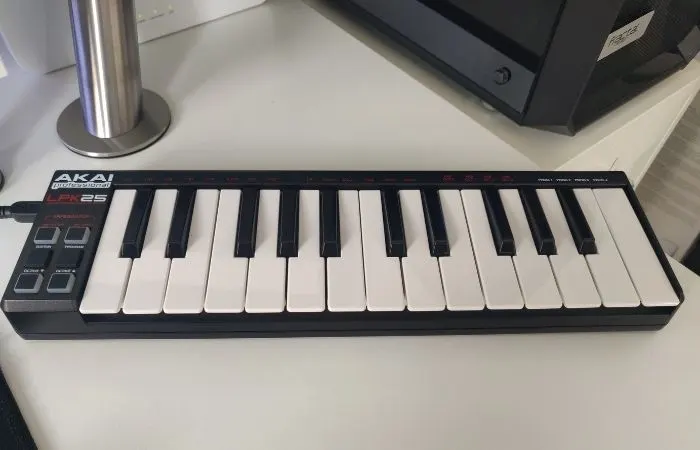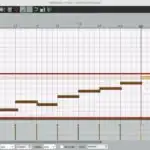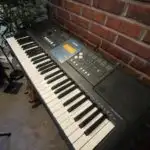Having a MIDI keyboard can improve your workflow and save you time while producing. However, it is more than possible for you to produce music without having a MIDI keyboard. There are a few different techniques that you can use to do this.
Producing Music Without A MIDI Keyboard
It is true that not having a MIDI keyboard controller may put you at a disadvantage to music producers that do, but don’t count yourself out!
There are still ways that you can produce high-quality and professional music without having a MIDI keyboard.
Learning these techniques will allow you to write and produce your music without spending the extra money on a MIDI keyboard. They may even help you stand out from producers that do!
In this article, I want to show you the different ways that you can still produce music without having a MIDI keyboard controller.

Using The Piano Roll
The first method for producing music without a MIDI keyboard that I want to show you is a standard tool with virtually every Digital Audio Workstation or DAW. The name of this tool is the piano roll.
What Is The Piano Roll?
The piano roll is a digital representation of a piano keyboard. You can use it to manually insert MIDI notes that will play through a virtual instrument plugin.
To use this method, you start by inserting a new track and placing a virtual instrument onto it. As we add notes onto the piano roll, the MIDI data will play through the virtual instrument that we have inserted.
The next step will be opening up the piano roll in your DAW.
How To Open Piano Roll
Each DAW, whether it be FL Studio, Pro Tools, Logic Pro, or Ableton, has a different way of opening the piano roll, but it will always be a simple process that you can find with a quick online search.
Here is a tutorial article on opening the piano roll in Ableton Live.
How To Open Piano Roll In Reaper
Also, I will show you how to open the piano roll in REAPER right here.
Once you have your track set up with a VST plugin and have had a chance to open your piano roll, you can start inserting MIDI notes by double-clicking where you want them to be in relation to a piano keyboard as well as their time placement within the track.
You can also alter the length of notes by clicking and dragging them where you want them to start or end.
How To Use The Piano Roll In Reaper
As you can see, the VST or sample instrument that you have on the track is playing the MIDI data that you enter on the piano roll.
Although this method takes a good amount of practice to master, if you invest some time into using it, it can be a very efficient way to produce music without a MIDI keyboard controller.
Virtual MIDI Keyboard
The following technique to produce music without a MIDI keyboard that I want to show you is the virtual MIDI keyboard.
The virtual MIDI keyboard is a tool that allows you to turn your standard computer keyboard into a MIDI keyboard. This is another tool that comes standard with almost every DAW.
Using The Virtual MIDI Keyboard In Reaper
First, insert a track in your DAW and place a VST plugin onto it to use this method.
Next, set the input to the correct one that your virtual MIDI keyboard is routed to in your DAW and arm the track to record.
With our track set up and armed for recording, we can open up the virtual MIDI keyboard. Here is how to do this in REAPER.
As we press the keys on our computer keyboard, we are triggering the corresponding notes on the virtual MIDI keyboard to play the MIDI data through our virtual instrument.
This technique is not easy to use at first, but you too can become a master with some practice and patience!
Loops and Audio Samples
Another technique that you can use for producing music without a MIDI keyboard is using loops and audio samples.
This method is as simple as dragging and dropping audio files from your computer into your DAW and arranging them using your mouse.
These audio files can be loops and samples you have purchased from sample packs or sounds you have recorded yourself.
Keep in mind that if you are dropping in loops to create a track, they will have to be set at the same tempo. They will also have to be in the same key signature if the sample is a melody, chord progression, or anything else that isn’t drums and percussion.
You can find sample packs for anything these days, including drum kits, basses, 808s, synths, guitars, vocals, and much more.
A savvy producer can create a track using nothing but loops if they are creative enough!
Although this is a straightforward way to produce music, it can also be quite limiting and even boring because you are not actually recording any parts yourself. Instead, you are combining fragments of other sounds and recordings.
If I can afford A MIDI keyboard, Do You Recommend That I get One?
Yes, I do. My goal with this article is to show people how to produce music if they cannot afford a MIDI keyboard controller or if they cannot have one for another reason.
If you can get yourself a MIDI keyboard, I definitely recommend doing so. It can improve your workflow as well as save you time while producing music.
Keep in mind that you can find a basic MIDI controller these days for a very reasonable price. Here is an example of an affordable and straightforward MIDI controller with almost all positive customer reviews.
I also want to show you a great example from AKAI as well as one from M-Audio. These are both excellent options that will cost you only a bit more than the first example.
Common Questions
What is a MIDI keyboard controller?

A MIDI keyboard controller is a device that looks like an electric piano. Instead of having speakers and sounding like a piano, you plug a MIDI keyboard controller into your computer or audio interface and use it to record MIDI data.
As you can see, your DAW displays MIDI data in the piano roll. The piano roll is a virtual representation of a piano keyboard.
If we put a sample instrument or VST instrument on the track that the MIDI data belongs to, the MIDI notes will play through that instrument that we have on the track.
You can play any sample instrument or VST instrument using a MIDI keyboard controller.
Can I use my electric piano as a MIDI keyboard, or do I need a MIDI specific device?

Many electric pianos allow for MIDI connectivity, so there is a good chance you will be able to use your electric piano as a MIDI keyboard.
In fact, I am currently using my decade-old YAMAHA keyboard as a MIDI keyboard in my home studio!
This all depends on how old your electric piano is and whether it has any MIDI ports. These will usually be on the back of the piano.
There are two types of MIDI ports that you will see on most electric pianos. These two types are USB MIDI ports and five-pin MIDI ports.
The other type of MIDI connection is TRS MIDI. TRS MIDI is much more uncommon than the other two types, but here is a guide on TRS MIDI in case that is what your device uses.
Suppose your electric piano does have one of these MIDI ports. In that case, using your piano as a MIDI keyboard is as easy as finding a suitable cable to connect to your computer or audio interface!
Here is a more in-depth breakdown of MIDI and the various MIDI connections.
What is the easiest way to connect a MIDI keyboard controller with your recording rig?
The easiest way to connect a MIDI keyboard with your recording rig is by using a USB MIDI cable. The reason for this is because USB MIDI allows you to plug your MIDI controller into your computer.
If you were to use five-pin MIDI or TRS MIDI, you would have to first connect your MIDI keyboard controller into your audio interface, which then connects to your computer.
The benefits of using USB MIDI are:
You only have to connect with one cable (MIDI keyboard > USB MIDI cables > computer).
Almost all keyboards these days have a USB MIDI port on them. It is debatable that USB MIDI ports are the most common type of MIDI connection.
Since you do not need an audio interface for this type of MIDI connection, you can produce music anywhere you can bring your computer and MIDI controller. With another kind of MIDI connection, you would also need your audio interface with you.
Final Words
Using the methods I have shown in this article, producing music without a MIDI keyboard is more than possible.
Because music production is a creative process, technological barriers such as lack of equipment will never restrict producers from creating music. There are always workarounds for these types of issues in a creative field.
However, there are obvious benefits to having a MIDI keyboard controller.
Keep in mind that the techniques demonstrated in this article are best used together instead of by themselves.
For example, you could produce a track by dragging and dropping audio loops to build a drum beat, using the virtual MIDI keyboard to record a synth chord progression, and then using the piano roll to construct a melody over the top.
Also, check out another article on a very similar topic for a few more tips: Do You Need A MIDI Keyboard To Make Beats?

 Want to connect with other music producers for help and guidance?
Want to connect with other music producers for help and guidance?